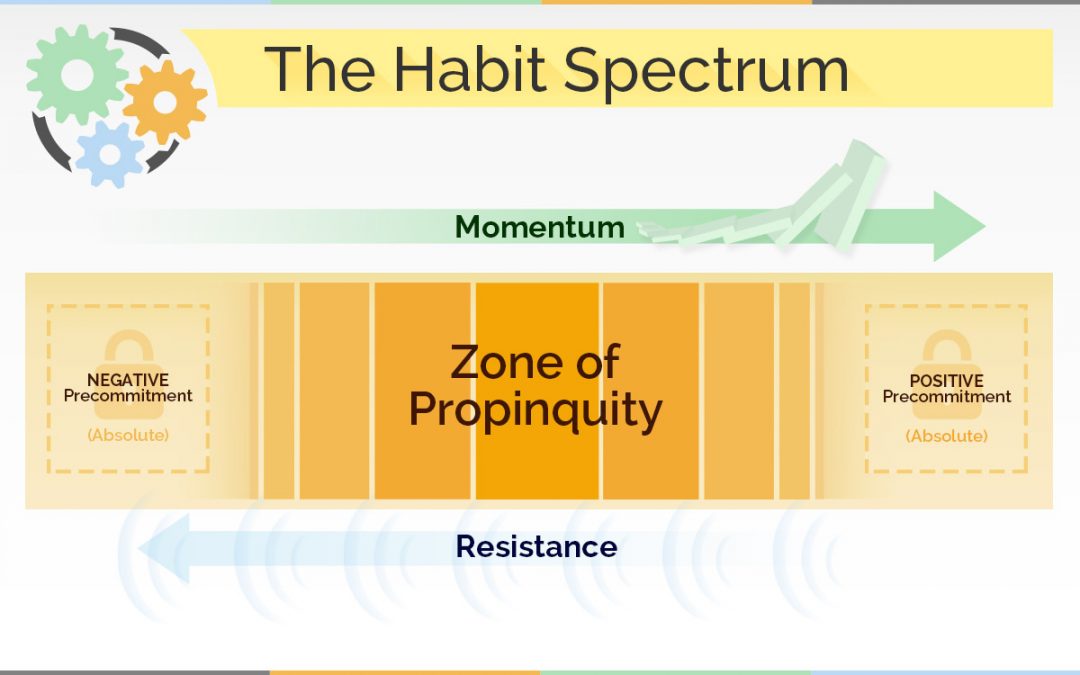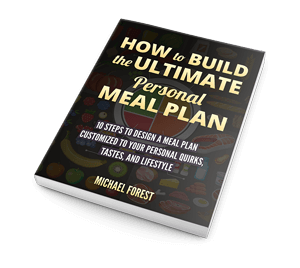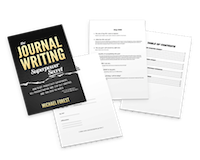The habit spectrum is designed to get you thinking about the forces at work in habit change, motivation, and achieving specific goals.
The habit spectrum, and the way I've visualized it, designed to help you think about what is working for you, and what is working against you.
(In other words, the habit spectrum is just something I currently use to organize my thinking about these things, and hopefully other people find this sort of thinking useful.)
Illustrated above in that image of the habit spectrum are two sets of forces: outer forces and inner forces.
- The outer forces, represented by the various shades of orange, include the “Zone of Propinquity” and either positive or negative pre-commitment. The outer forces are all about the physical, material world. By this I mean the actual, “real” world, not just your interpretation of it. In a really simple way, I just mean physical stuff, as in, the stuffness of stuff, the material of material.
- The inner forces include momentum on the one hand (green pushing you forwards on top), and resistance on the other (blue pushing you backwards on the bottom). Momentum and resistance are opposing forces. (Resistance is devious, though. It'll try to “feed” off momentum.) Momentum and resistance are influenced by the outer world, as well as by the whole rest of your mind and all your thoughts, and everything in your mind that makes you “you.”
In other words, you experience momentum and resistance inside your head, and they are technically a “part” of you, but they are not you. You are separate from these things.
If you only get one thing from this post, it should be this:
The inner forces and the outer forces overlap, intersect, and influence one another, in a back and forth kind of way, so that “outer world” and “inner world” blend and blur together… and your habits exist in both the inner world and the outer world.
Most people would say a habit is in the inner world. It's in your mind. Okay, but first of all, like all thoughts, habits are physical things (meaning they are specific neural impulses in your actual, physical brain, and you can actually see them if you have the right equipment).
More than that, a habit includes three parts: a trigger (or cue), a routine, and a reward.
Your brain or mind knows to “recognize” the triggers or cues, but these triggers or cues are often physical, material events or things. For example, you see a brand logo like Doritos in the grocery store and start craving chips, or you see a visual cue like that little red dot on your email app icon that makes you crave the reward you get opening a new email. These are physical elements. If you remove or manipulate them, you remove or manipulate the habit.
Indeed, I would say “habits” live right in the middle of the Zone of Propinquity.
Outer Forces
Degrees of Propinquity and Absolute Precommitment
The Zone of Propinquity

The middle, orange spectrum is all about your environment and what you physically, actually do in your environment.
In the middle you have the Zone of Propinquity. (Shout out to Chris Fox for the term “propinquity.”) The Zone of Propinquity is all about “closeness” or “affinity.” It’s about what is convenient, nearby, and easy, in a physical or material sense.
Eating a bag of chips because it was already open and “just there” is convenience. On the flip side, not eating a bag of chips because it’s down in the kitchen and you’re up in the bedroom is also about propinquity. Propinquity is all a matter of degree.
The convenience or inconvenience of something can serve you and your goals, or work against you and your goals. The world itself doesn't care whether it is one or the other. The world is indifferent.
You can take this further than the obvious examples. Not starting a business because you don’t have any kind of network and you have no money is also a matter of propinquity. In a very real way, you are distant from the things that would make starting a business much easier. This is a material obstacle.
These real-world obstacles are not just in your mind, though certainly they will influenceyour mind.
You can overcome these obstacles, but they will influence things like your motivation. It will be easier to accomplish your goals if you have fewer obstacles and more stepping stones.
Think about this on a basic level.
If you have a membership at a gym that is an hour away, if you have lots of motivation, you can overcome this and still go to the gym on a regular basis. It's not impossible. But your internal resistance, that inner force that doesn’t want you to achieve your goals, will feed on this as an excuse. Your internal resistance will whisper, “Oh, man, that’s a long drive. You should skip it today. Maybe tomorrow.” (Note: Resistance turns external obstacles into internal excuses.)
Again, you can still overcome this (resistance is just a voice in your head, it's not “you”), but it’s harder, and you don’t want to feed resistance. You want to starve it. If you have a gym right around the corner from your apartment, stopping off there on your way to work or on your way home is much easier. In this latter case, resistance has less “material” to feed on, so it will be quieter.
You can manipulate the zone of propinquity
You have free will. This means you can manipulate propinquity simply be re-arranging your environment and being a little strategic.
Set up your environment so that the things that will take you towards your goals are easy and convenient to do, and the things that will take you away from your goals are difficult and hard.
Setting up a clean work space helps you get work done. Buying gym clothes helps you go to the gym. Buying nutritious whole foods and a fully-stocked fridge helps you make nice meals at home.
Examples of Manipulating Propinquity
- Having your work desk already set up for you each morning (by doing it the night before), if your goal is to write or get something done the first thing you do when you wake up.
- Having your running shoes as well as all your workout clothes set out the night before, or at least packed and ready to go.
- Having several sets of workout clothes so you don’t need to do laundry every single day.
- Having your meals pre-packed and ready to go.
- Making sure that you buy enough groceries that you’ll make it through to your next trip to the grocery store.
- Having “back up” meals that you can conveniently rely on or fall back on when life gets hectic.
- Having “go to” fast-food meals that are still basically on diet; for example, knowing you can always go to Subway (since it’s always “nearby” after all!) and grab such-and-such a sandwich with such-and-such toppings.
Precommitment
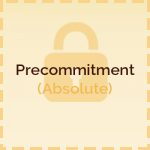 On the far sides of each end of the propinquity spectrum is “precommitment.”
On the far sides of each end of the propinquity spectrum is “precommitment.”
Precommitment is propinquity taken to the extreme. Precommitment is when your environment is setup such that you have no choice but to act a certain way. Propinquity makes certain choices easy; precommitment removes choice entirely.
I put them on the “far sides” of the spectrum, but the fact is precommitment can fall anywhere. You can precommit to something that is normally hard and unpleasant, or you can precommit to something that was already easy and convenient (you've just eliminated any choice in the matter).
Let's say use gym that is an hour away as an example. From the perspective of the Zone of Propinquity, it is far, distant, inconvenient. You could devise a way to overrule that, and “precommit” to going no matter what by getting some co-workers together for a carpoolm and setting things up so that your “ride home” from work was actually a ride to the gym. You don't really have a choice in the matter anymore; if you want to get home, first you gotta go to the gym with your co-workers.
“Pure” or “Absolute” precommitment is rare, but it is something to strive for, at least in terms of the things you need to do to reach your goals.
For example, if you like to snack on peanut butter but you have no peanut butter in the house, that is about as close to precommitment as you can get without doing something crazy. If you crave peanut butter, at some point your internal resistance will feed you a bunch of rubbish about how “just one” tablespoon is no big deal, and blah blah blah. Thankfully, that doesn’t matter, because there ain’t no peanut butter in the house. Resistance can suck it.
However, as I said, “true” or “absolute” precommitment is hard to achieve in the real world. It’s more like a Platonic ideal. With our peanut butter example, even that is not “true” precommitment. If your resistance is strong enough, then I suppose you could give in, hop in your car, and go buy some peanut butter.
Technically speaking, in this example we’re still in the zone of propinquity, but we’re close enough to absolute precommitment that most people won’t actually give in to a craving.
You could move out to the middle of nowhere or something, but I recommend instead that you learn to rely a little bit on your motivation and willpower. Take care of the outer stuff as much as you can; after a certain point, life is just gonna throw unexpected crap at you, and you just gotta deal with it.
Two important notes about precommitment:
- First, like the Zone of Propinquity, precommitment can be positive or negative, meaning that it can serve you or not serve you. You can have “no choice” but to do things that will serve your goals, or you can have “no choice” but to do things that won’t serve your goals. The universe doesn't care about your goals. You do care, so you have to manipulate the universe accordingly (or as much as you can).
- Second, precommitment isn't necessarily a conscious act; it's just a physical reality. Whether or not you consciously precommit to something doesn't change whether or not you find yourself in that situation. If you find yourself in a situation where you have no choice but to do or act in a certain way (relative to your goals), by definition that is precommitment, and it doesn't matter whether you consciously planned to be there or if you just sort of “found yourself” in that situation. It happened. It's a physical reality. (Ideally, then, you should consciously plan to avoid situations of precommitment that won't serve you, and choose to consciously create situations of positive precommitment that do serve you).
Examples of Absolute Precommitment
- Going to a treatment center, where you literally cannot access the drug you are addicted to.
- Destroying all the peanut butter in the world. (Don’t do this.)
- Many forms of bariatric surgery.
Examples of Near Absolute Precommitment
(i.e. more “real world”)
- Throwing out the junk food in your home that you know you crave every single night.
- Trying to go to the gym regularly when you don’t have a gym membership, and you don’t even know where any of the local gyms are. (This is negative precommitment.)
- Forcing yourself to be physically at the gym when you want to work out. (Once you’re there, it’s pretty hard to be in the weight room and just… not.)
- Running in a direction that is away from home for X minutes, so that to get back home, you’ll need to run the same number of minutes back.
Inner Forces
Momentum and Resistance

Resistance
Let’s talk about resistance, first.
Resistance is the little voice inside your head telling you to do it later, or telling you that you’re not good enough, that this thing you’re working on totally sucks, and you should just trash it and start something new. (Hello writers with a dustbin full of half-finished novels.)
Fighting against resistance is like fighting against the wind. You can’t get rid of it. It’s there. You just have to push through it. You do this by manipulating the middle spectrum, by taking advantage of momentum, and by exercising sheer force of will.
I got the term “Resistance” from Steven Pressfield.
Here is what he says:
Resistance is an active, intelligent, protean, malign force — tireless, relentless, inextinguishable — whose sole object is to stop us from becoming our best selves and from achieving our higher goals.
Pressfield gives seven principles related to resistance:
Principle 1. There is an Enemy
My translation: resistance exists; there is no getting around this.
Principle 2. The Enemy is Implacable
My translation: You will always have some degree of resistance.
Principle 3. The Enemy is Inside You
My translation: At the end of the day, resistance is your inner game. Resistance is notthe actual real-world obstacle; Resistance just latches onto these things to screw you over.
Principle 4. The Enemy is Inside You, But it is Not You
My translation: Do not feel guilt about resistance. It is not “you.” It is the enemy. Everyone has it.
Principle 5. The ‘Real You’ Must Duel the ‘Resistance You’
My translation: You have to slay resistance, because it will stand in you path, if you want to improve yourself.
Principle 6. Resistance Arises Second
My translation: First you have a dream, a goal. Resistance comes later, when you have to deal with the process of getting to that dream. (Pressfield notes that the dream is based on love. Resistance is the entrance of fear.)
Principle 7. The Opposite of Resistance is Assistance
My translation: there is a force that, rather than standing in your way, helps you towards your goals. This is the dream, or love, or what-have-you. (I somewhat disagree with principle 7. I think the true opposite of resistance is momentum. But this is a quibble and beside the point.)
One of the most important aspects of resistance is that it will FEED on any excuse it can muster. ANY excuse. This is why the physical world, the outer game, has to be taken care of. You need to cut it off before it can get going.
Remember that resistance is not the same as the actual obstacles standing in your path. Those outer forces are actual, material things. Resistance isn't. Resistance is just a voice inside your head. Resistance is feeding on those actual, real things, but resistance doesn't see the world objectively, so screw it. Resistance sees everything through a lens coloured by fear and doubt.
You need to manipulate your environment (and feel smart and amazing while doing it, in order to feed momentum) so that resistance doesn’t have the fuel it needs to fight back. When you get your outer game right, you starve Resistance. It’s still there, but it is weak, starving, barely able to croak out more than a token complaint.
By contrast, when you’ve manipulated your outer environment and strategically set up habits that serve you, you’ve fed momentum (and you know you’ve fed momentum, which just feeds momentum even more) and so you can just pile drive on through to your goals.
Momentum
 If resistance is wind in your face, momentum is the sense of having wind at your back.
If resistance is wind in your face, momentum is the sense of having wind at your back.
Momentum is the true “opposite” of resistance, because like resistance, you are not your momentum. Momentum is just a force.
Momentum builds and builds. When it grows powerful enough, your inner resistance does not stand a chance against it, because what was “hard” and weird and difficult is now simply… a habit. By this point, you won’t even need momentum anymore, because certain acts, certain decisions, are now habitual and normal, rather than weird and uncomfortable.
Momentum is what makes the weird and uncomfortable seem normal and comfortable before these things are turned into habits… at which point they actually become normal and comfortable.
Keep in mind these principles of momentum:
- You are not your momentum.
- By itself, momentum is not enough to overcome resistance permanently.
Momentum feeds on perfection, on strings of successes, on the build-up of small wins. When you rely on momentum all by itself, however, you leave yourself open to experiencing the “What the hell” effect. It leads to being “on” or “off” the bandwagon. Be wary of this. Avoid it. Use momentum as a tool, but it's not you, just a part of you, a wave you can ride temporarily.
So, when you do have a screw up, or a mess up, and momentum goes out the picture, what are you left with?
Just… nothing?
No, of course not. Don't be silly.
YOU. You’ve still got you.
Remember I said that you are not your Resistance, and you are not your Momentum. You have a will that is free and totally separate from your resistance, your momentum, your physical habits. You have desires, cravings, second thoughts, hopes, dreams. By themselves, none of these things are “you.” They are just a part of you.
There is always an element that is fundamentally separate, and fundamentally “you.” This is what decides what to do, how to think. It is always there, and it is always separate from whatever individual thoughts you have (whether those thoughts serve you or don’t serve you).
How These Things Work Together
The Inner Forces and the Outer Forces influence one another.
Here are some examples:
- When you pre-commit to something, that initial decision feels good, because you know you are making a smart, intelligent decision that serves you. This builds momentum and silences resistance.
- Resistance is a wily one. It will even try to use yourmomentum as an excuse: “You're doing so well, all the more reason you deserve a break!”
- If you think through and are mindful of all the elements of your life that resistance tends to “feed on,” you can address these first. You can cut off resistance before it grows louder and louder, or just plain make it irrelevant.
- When you “rely” on some form of pre-commitment (e.g., you “give in” to resistance), but are kept in check by that pre-commitment (e.g., you crave X, but have no X in the house), you not only make the resistance irrelevant, but you help build momentum going forward.
- The simple act of manipulating your outer environment, and making choices to optimize things, creates an internal locus of control. Regardless of how much your choices do or do not actually improve things, the act of making these choices builds that locus of control, builds a sense of self-efficacy, and these in turn build motivation and silence resistance.
- The act of manipulating your outer environment also lets you “dig in” to all the opportunities you have to actually make things work. That is, if you have a lofty goal, digging into how you'll make it work makes that goal seem possible. Nothing feeds resistance like thinking something is impossible — the only way to fight this is to prove to yourself that, actually, it really is possible.
- When momentum lasts long enough, it stops being “momentum.” It just becomes an actual, physical habit. Momentum is what allows you to do the uncomfortable, weird, and the new. Do it long enough, though, and it becomes comfortable, routine, habit. This is the goal. (This is another whole post.)
Exercises and Ideas
(i.e. how to make any of this useful)
 Here are some exercises/ideas to get you to actually take advantage of this stuff. The trick is to actually write these down. (Trust me. It makes them more real.)
Here are some exercises/ideas to get you to actually take advantage of this stuff. The trick is to actually write these down. (Trust me. It makes them more real.)
- Write down all the things in your environment and day to day life that your personal resistance feeds on. (Your resistance is not my resistance.)
- What does your resistance tend to focus on? What excuses? What can you do to remove those excuses? If you can’t manipulate your environment to remove them, what can you simply do to “overcome” them (and prove resistance wrong, and thus shut it up)?
- Write down all the “stepping stones” in your environment that you can take advantage of, and think about whenever resistance wants to talk about how hard everything is.
- Brainstorm a few more stepping stones. What do you need to do every day, and how can you make it easier? How can you manipulate the zone of propinquity?
- What are some small daily wins that will help you build momentum each and every day?
- What are some larger wins in your life? What did they illustrate about your ambition, discipline, drive, passion – whatever? Use these as counter-arguments to drown out resistance, and to build momentum.
- When is resistance strongest? When do you feel like you can’t do it, or crave a food, or just “don’t feel like it”? Literally: what time of day does this happen? Now, implement a physical change to your life and/or environment that deals with it.
